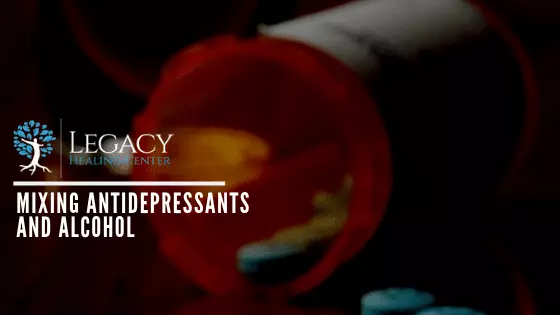Recognizing the Signs of Alcoholism & What to Do Next
Alcoholism is the most common substance use disorder in the United States. According to the National Survey on Drug Use and Health (NSDUH), 29.5 million Americans over the age of 12 (10.5% of this population) had a diagnosable alcohol use disorder in 2022.
Social drinking. Heavy drinking. Binge drinking. Problem drinking. All of these classifications have different definitions, but they do not necessarily mean a person is an alcoholic. So, how can you tell if a person you care about is suffering from alcoholism? Unfortunately, it’s not always easy to know for sure. However, there are a few telltale signs of alcoholism that you may be overlooking.
There is hope!
Download our free Addiction Recovery Guide for Families and learn about addiction, how it’s treated, and how to heal for a more meaningful life.
What Is Alcoholism (Alcohol Use Disorder)?
Alcohol use disorder (AUD), better known as alcohol addiction or alcoholism, is a diagnosable disease with symptoms outlined in the Diagnostic and Statistical Manual (DSM-5).
A medical professional can diagnose a person with AUD if they’ve exhibited at least two of the following behaviors in the last year:
- You drank more or longer than you originally planned to
- You’ve unsuccessfully tried to cut down or stop drinking more than once
- You spent a lot of time drinking and/or hungover
- You wanted a drink so badly that you couldn’t focus on anything else
- Drinking or being hungover kept you from fulfilling familial, work, or school responsibilities
- You kept drinking even though it caused issues with your loved ones
- Drinking has kept you from engaging in the activities you once enjoyed
- You’ve been in unsafe situations while drinking (e.g. driving)
- You drank even though it made you black out, anxious, and/or depressed
- You need to drink more and more to feel the effects
- You experience withdrawal symptoms, like sleep issues, shakiness and nausea, when the alcohol starts to wear off
If you meet two to three of the criteria, you can be diagnosed with mild AUD.
If you meet four to five of the criteria, you can be diagnosed with moderate AUD.
If you meet six or more of the criteria, you can be diagnosed with severe AUD.
Alcoholism is different than binge drinking and heavy drinking:
- Binge drinking is defined as a man having five or more drinks in under two hours or a woman having four or more drinks in under two hours.
- Heavy drinking is defined as a man having five or more drinks on any one day or 15 drinks in a week. For women, it’s having four or more drinks on any one day or eight drinks in a week.
Alcoholism can certainly lead to binge and heavy drinking. However, just because you have engaged in binge drinking, for example, does not necessarily mean you have AUD.
13 Warning Signs of Alcoholism

There are many signs that someone may be a victim of alcoholism, with some of the most common being:
- Increased Tolerance: The victim needs to consume larger amounts of alcohol to achieve the same effects.
- Physical and Mental Dependence: The victim must drink alcohol in order to function “normally”.
- Withdrawal Symptoms: Common alcohol withdrawal symptoms include nausea, sweating, irritability, shaking or tremors, and hallucinations.
- Loss of Control: The victim cannot limit or control their alcohol consumption.
- Dominance of Alcohol in Victim’s Life: The victim spends significant time thinking about, obtaining, using, and recovering from the effects of alcohol.
- Neglect of Responsibilities: The victim neglects personal, professional, financial, familial, and legal responsibilities due to alcohol use.
- Continued Use Despite Consequences: The victim continues to consume alcohol despite experiencing negative consequences as a result of doing so, such as health or legal issues, strained relationships, or financial hardships.
- Social Isolation: The victim withdraws from social activities or avoids friends and family as a result of alcohol use or its consequences.
- Drinking to Cope: The victim uses alcohol as a coping mechanism to deal with stress, anxiety, trauma, boredom, or emotional difficulties.
- Increased Risk Taking: The victim engages in increasingly risky behaviors while under the influence, such as driving or participating in dangerous activities.
- Changes in Physical Appearance: The victim displays flushed skin, broken blood vessels, weight loss or gain, injuries, or a lack of personal hygiene.
- Denial: The victim persistently denies the severity of their alcohol use.
- Failed Attempts to Quit: The victim has never been able to cut back on or quit drinking alcohol for an extended period of time.
Signs of Alcohol Poisoning (Overdose)
The average number of annual deaths in the United States due to alcohol rose 29% between 2016 and 2021, and alcohol poisoning was one of the leading causes. If you believe your loved one is suffering from alcoholism, is it incredibly important that you’re able to recognize the signs of alcohol poisoning. Doing so may allow you to save their life.
Alcohol poisoning, or alcohol overdose, occurs when an individual has consumed a fatal amount of alcohol. Signs of it include:
- Confusion or stupor
- Vomiting and retching
- Seizures and spasms
- Slow, irregular, or stopped breathing
- Hypothermia
- Cold or clammy skin
- Pale, bluish, or gray skin, especially on the lips or fingertips
- Unconsciousness
- Unresponsiveness
- Unable to wake up
If you suspect someone may be suffering from alcohol poisoning, take the following steps.
- Immediately call 911.
- Turn them on their side if unconscious.
- Stay with the person until emergency services arrive.
- Try to keep them awake.
- Do not give them food, coffee, or a cold shower.
Signs of Fatal Alcohol Withdrawal

Alcohol withdrawal can kill you, and is responsible for hundreds of fatalities in the US every year. Delirium tremens, the DT, is a severe form of alcohol withdrawal that is responsible for most of these fatalities.
DT is characterized by hallucinations, seizures, and extreme agitation. The seizures caused by alcohol withdrawal are the single symptom which is most likely to cause death. Other signs someone may be dying of alcohol withdrawal include irregular heartbeat and hyperthermia.
If you suspect someone is experiencing potentially deadly alcohol withdrawal symptoms, seek out emergency medical attention immediately. If the victim is treated in time, medications like benzodiazepines and other interventions can save their life.
While waiting for emergency services to arrive, you should remain with the victim and try to prevent them from injuring themselves while seizing.
Short- and Long-Term Effects of Alcoholism
Alcohol use disorder can have many negative effects on a person’s health and life.
Short-term effects of alcoholism include:
- Intoxication
- Impaired judgment
- Accidents
- Injury
- Strained relationships
- Legal difficulties
- Problems at work or school
- Death
Long-term effects of alcoholism include:
- Liver disease
- Cardiovascular issues
- Decline in mental health
- Increased risk of cancer
- Job loss
- Social isolation
Luckily, reducing or quitting alcohol can reverse some of these negative effects and offers significant benefits like improved cognitive function, reduced risk of chronic disease, and overall well-being.
How to Help Someone Who May Be Suffering from Alcohol Use Disorder

If you suspect that a loved one is suffering from alcoholism the first thing you should do is research the condition and potential treatment options. Use what you have learned to develop a clear plan of action.
Choose a calm and private setting to have a conversation with them. Approach them with empathy and avoid blame at all costs. Tell them your concerns and emphasize your support.
Finish the conversation by encouraging them to seek professional help and provide them with the information you have gathered.
Some treatment options you can discuss with them include:
- Medically supervised alcohol detox
- Inpatient alcohol rehab
- Outpatient alcohol rehab
- Group and individual counseling
- Support groups like Alcoholics Anonymous and SMART Recovery
Help your loved one figure out what addiction services their insurance will cover and look into alternative payment options if needed.
Finally, to ensure you aren’t enabling their behavior, you must set clear, healthy boundaries with consequences. Also, avoid covering up their actions or providing financial support for anything other than treatment.
The conversation may not go as you plan, but do not lose hope. What’s most important is that you’ve acknowledged the problem and opened the door to potential treatment options. From there, it is up to your loved one to take action for the sake of their health and your relationship. Continue to remind them that you love them and will always be there to support them on their recovery journey.
Achieve Sobriety through Professional Alcoholism Treatment
Alcoholism is a deadly disease that both ruins and ends lives. However, the right professional treatment can improve and save lives.
Legacy Healing is dedicated to helping you or your loved one overcome alcoholism and start living a meaningful life of sobriety.
We know that alcoholism is a complex disease and the only way to fully heal is to treat the mind, body, and spirit. That’s why we utilize a three-pronged approach that emphasizes using the right psychotropic medications, cutting-edge clinical therapies, and peer support from those who know what you’re going through.
Call 888-534-2295 to speak with a treatment staff member about how we can help you or your loved one overcome alcoholism.
Signs of Alcoholism FAQs
What are the common signs of alcoholism?
Common signs of alcoholism include increased tolerance, physical and mental dependence, withdrawal symptoms, neglecting responsibilities, negative consequences from alcohol use, and failures to cut down on or quit drinking.
How does alcoholism affect physical health?
Alcoholism can have many negative effects on physical health, including liver disease, cardiovascular problems, weakened immune system, neurological damage, ulcers, reduced bone density, and reproductive issues, just to name a few.
What are the behavioral and social indicators of alcohol addiction?
The behavioral and social indicators or alcohol addiction include:
- Neglect of personal, professional, familial, financial, legal, or other responsibilities
- Isolation from social activities and relationships
- Continuing to use alcohol despite negative consequences
- Needing more alcohol to achieve the same effects
- Spending significant time thinking about, obtaining, using, or recovering from alcohol
- Drinking in dangerous situations
- Engaging in deceptive or secretive behavior
- Experiencing unstable relationships
- Legal issues involving alcohol
- Loss of interest in previously enjoyed activities
What should I do if I suspect someone is struggling with alcoholism?
If you have identified alcohol dependency signs and suspect someone struggling with alcoholism, there are a number of steps you can take.
- Educate yourself about alcoholism and treatment options.
- Choose a calm and private time and place to talk to your loved one about your concerns.
- Avoid accusations or blame.
- Suggest them to seek treatment at a detox facility or inpatient rehab.
- Do not enable their behavior.
- Be supportive.
What treatment options are available for alcohol addiction?
There are a number of treatment options available for alcohol addiction, including:
- Inpatient rehab and detox programs
- Outpatient rehab programs
- Group and individual counseling
- Medication-Assisted Treatment (MAT) like disulfiram, naltrexone, and acamprosate
- Support groups like Alcoholics Anonymous and SMART Recovery
Sources
- National Institute on Alcohol Abuse and Addiction. (2023). Drinking Levels Defined.
- Department of Drug and Alcohol Programs. (N/A). Alcohol Poisoning or Overdose.
- Penn Medicine. (2023). What Is Alcoholism?
- National Institute on Alcohol Abuse and Alcoholism. (N/A). Understanding Alcohol Use Disorder.
- Centers for Disease Control and Prevention. (2019). What Is Excessive Alcohol Use?
- Centers for Disease Control and Prevention. (2023). Alcohol Use.
- National Institute on Alcohol Abuse and Alcoholism. Alcohol Use Disorder (AUD) in the United States: Age Groups and Demographic Characteristics.
- USA Today. (2018). Quitting Alcohol Can Be Deadly: Hundreds in the US Die Each Year.
- Centers for Disease Control and Prevention. (2024). Deaths from Excessive Alcohol Use – United States, 2016-2021.






